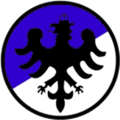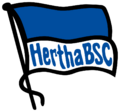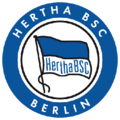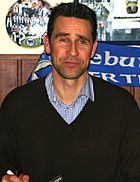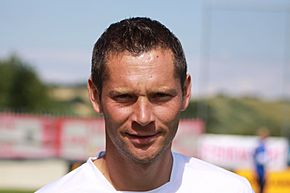Hertha BSC facts for kids
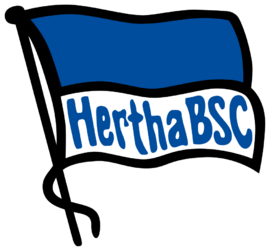 |
|||
| Full name | Hertha, Berliner Sport-Club e. V. | ||
|---|---|---|---|
| Nickname(s) | Die Alte Dame (The Old Lady) | ||
| Founded | 25 July 1892 | ||
| Ground | Olympiastadion | ||
| Capacity | 74,475 | ||
| Limited shareholders | 78,8 %: 777 Partners 21,2 %: Hertha BSC e. V. |
||
| President | Fabian Drescher | ||
| Head coach | Stefan Leitl | ||
| League | Bundesliga | ||
| 2020–21 | Bundesliga, 14th of 18 | ||
|
|
|||
Hertha BSC, also known as Hertha Berlin, is a professional football club from Berlin, Germany. They currently play in the 2. Bundesliga, which is the second-highest football league in Germany. Hertha BSC was founded in 1892. They were also one of the clubs that helped start the German Football Association in 1900.
The team won the German championship twice, in 1930 and 1931. Since 1963, Hertha's home stadium has been the Olympiastadion. The club is often called Die Alte Dame in German, which means "The Old Lady."
Contents
- Club History: How Hertha BSC Started
- Hertha Joins the Bundesliga
- Ups and Downs: A Period of Change
- Hertha's Home: The Olympiastadion
- Team Colors and Kits
- Club Crests Through the Years
- Meet the Players: Current Squad
- Coaching and Staff
- Club Achievements and Trophies
- Hertha BSC in European Football
- Women's Football at Hertha BSC
- See also
Club History: How Hertha BSC Started
Early Days and Name Origin
The club began in 1892 as BFC Hertha 92. Its name came from a steamship with blue and white smokestacks. One of the four young founders had taken a trip on this ship with his father. The name Hertha is also linked to Nerthus, a goddess from old Germanic stories.
Hertha played very well from the start. They won the first Berlin championship final in 1905. In 1910, Hertha even won a friendly match against Southend United from England. This was a big deal because football started in England, and English clubs were very strong.
However, the club faced money problems. In 1920, Hertha merged with a wealthier club called Berliner Sport-Club. This created Hertha Berliner Sport-Club. The new team continued to be very successful in the Oberliga Berlin-Brandenburg. They reached the German championship final six times in a row from 1926 to 1931. They won the title in 1930 and 1931. After their first championship, BSC became a separate club again. Hertha was Germany's second most successful team between the two World Wars.
Football During the Third Reich
In 1933, German football was reorganized into 16 top divisions. Hertha played in the Gauliga Berlin-Brandenburg. The club continued to do well in their division, often finishing high in the standings. They won their divisional title in 1935, 1937, and 1944. However, they did not advance far in the national championships. During this time, the club's leadership changed, with a Nazi party member, Hans Pfeifer, becoming president.
Post-War Football in Berlin
After World War II, Berlin was divided, which made things difficult for football. Hertha was not allowed to play against teams from East Germany in the 1949–50 season. This happened because they took on players and a coach who had moved from the Dresden club SG Friedrichstadt to West Berlin. Many teams from East Berlin were moved to a new league called the DDR-Liga.
In the 1950s, Hertha had a strong rivalry with Tennis Borussia Berlin. There was a suggestion to merge the two clubs in 1958, but it was rejected by most members.
Hertha BSC had fans all over Berlin. But after the city was divided by the Berlin Wall in 1961, it became hard and dangerous for fans in East Berlin to support the team. Some fans, like Helmut Klopfleisch, would gather near the wall to listen to the sounds from the stadium. When the crowd cheered, they would cheer too. This made them suspicious to the East German secret police, the Stasi.
Hertha Joins the Bundesliga
When the Bundesliga (Germany's top professional league) was formed in 1963, Hertha was Berlin's champion. This meant they became one of the first teams in the new league. However, after the 1964–65 season, Hertha was moved down a league. This was due to problems with trying to get players to play in Berlin, especially after the Berlin Wall was built.
Because the Bundesliga wanted a team from Berlin for political reasons, another team, SC Tasmania 1900 Berlin, was promoted. This team ended up having the worst performance in Bundesliga history. Hertha returned to the top league in 1968–69 and became Berlin's most popular team.
In 1971, Hertha was involved in a match-fixing scandal with other clubs. An investigation also showed that the club was in a lot of debt. They avoided financial ruin by selling their old home stadium.
Despite these challenges, the team had some success in the 1970s. They finished second in the Bundesliga in 1974–75. They also reached the semi-finals of the 1978–79 UEFA Cup and played in two DFB-Pokal finals (1977 and 1979). However, in the next season, their luck changed, and they were moved down to the 2. Bundesliga. They spent 13 of the next 17 seasons there.
Plans in 1982 to merge with other Berlin clubs did not happen. Hertha even dropped to the third division, the Amateur Oberliga Berlin, for two seasons (1986–87 and 1987–88). When they did return to the Bundesliga (1982–83 and 1990–91), they were quickly moved down again because of poor results. Hertha's amateur team had more success, reaching the DFB-Pokal final in 1993, where they lost 0–1 to Bayer Leverkusen.
After the Berlin Wall fell, Hertha became very popular in East Berlin. Just two days after the wall came down, 11,000 East Berliners came to watch Hertha play. A friendship grew between Hertha fans and Union Berlin fans. A friendly match between the two clubs attracted over 50,000 spectators.
In 1994, the club faced more money problems with a large debt. This crisis was solved by selling some property and getting a new sponsor and management team. By 1997, Hertha was back in the Bundesliga. They usually finished in the top third of the league. When Hertha was promoted in 1997, it meant that Berlin finally had a team in the Bundesliga again after six years.
Ups and Downs: A Period of Change

Hertha's return to the Bundesliga started well. They played in international competitions like the UEFA Cup and the UEFA Champions League starting in 1999. They also signed important players like Pál Dárdai in 1997, who became Hertha's most-played player ever. Other key players included Sebastian Deisler in 1999 and Brazilian player Marcelinho in 2001, who was named the Bundesliga's Player of the Year in 2005. Hertha also invested a lot in its youth football academy.
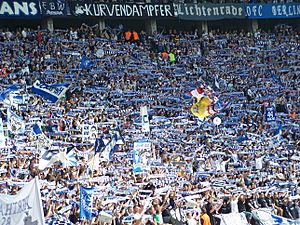
However, Hertha could not keep up their strong performance. The next few years had many highs and lows. The team almost got moved down a league in the 2003–04 season. But they bounced back and finished fourth the next season. They just missed out on the Champions League spot on the final day. In 2005–06, Hertha finished sixth and qualified for the UEFA Cup. They were knocked out in the first round.
In 2006–07, Hertha finished tenth. They started the 2007–08 season with a new manager, Lucien Favre. Hertha finished tenth again but qualified for the UEFA Cup and reached the group stage. After a strong season in 2008–09, where they finished fourth and were in the title race until near the end, the club had a very difficult season in 2009–10. They finished last in the Bundesliga and were moved down a league.
After one season in the 2. Bundesliga (2010–11), Hertha earned their way back to the Bundesliga for 2011–12. However, they finished 16th and lost in a playoff to Fortuna Düsseldorf, sending them back to the 2. Bundesliga.
In 2012–13, Hertha won the second division championship for the second time in three seasons, earning promotion again. On the first day of the 2013–14 season, they beat Eintracht Frankfurt 6–1 at the Olympiastadion.
On February 5, 2015, Pál Dárdai, Hertha's longest-serving player, became the main team's manager. At the middle of the 2015–16 Bundesliga season, Hertha was in third place. Despite a dip in performance later in the season, Hertha still finished seventh. This meant they qualified for the Europa League in the 2016–17 season. They lost in the play-off round to Brøndby.
In the 2016–17 Bundesliga season, Hertha had their best start ever in terms of points. They finished the season in 6th place and qualified for the 2017–18 Europa League group stage.
Recent Years and Changes
In June 2019, Lars Windhorst bought a large share in the club. On November 27, 2019, Jürgen Klinsmann became the new manager, but he left after only 76 days. Bruno Labbadia took over in April 2020.
In 2020, Windhorst invested even more money into the club. However, this did not lead to more success on the field.
On January 24, 2021, Labbadia was fired, and former manager Pál Dárdai returned. Dárdai helped the club stay in the league, but he was replaced by Tayfun Korkut after nine months. Korkut was fired after just four months, with the club near the bottom of the table. Felix Magath then took over. Magath helped the club avoid being moved down by winning a play-off against Hamburger SV. After this, Magath was replaced by Sandro Schwarz.
However, relations between Hertha and Windhorst became difficult. Schwarz was fired in April 2023 after a big loss, which left Hertha at the bottom of the league. Pál Dárdai became head coach for the third time, but he could not stop Hertha from being moved down a league. Hertha was relegated after a late goal by VfL Bochum on the second to last matchday of the 2022-23 season.
Hertha's Home: The Olympiastadion

Since 1963, Hertha BSC has played its home matches at Berlin's Olympiastadion. This stadium was originally built for the 1936 Summer Olympics.
The Olympiastadion can hold 74,649 people, making it the largest stadium in Germany by seating capacity. For some football matches, like those against Bayern Munich, more seats can be added, bringing the capacity to over 76,000.
The stadium has been renovated twice, in 1974 and from 2000 to 2004. These renovations were done for upcoming FIFA World Cup tournaments. For the 2006 World Cup, the stadium was thoroughly modernized. The running track was also changed to blue to match Hertha's club colors. Besides Hertha's games, the Olympiastadion also hosts matches for the Germany national football team, concerts, and the annual DFB-Pokal final. It hosted six matches during the 2006 World Cup, including the final game.
Before the Olympiastadion, Hertha played at different grounds. Their first home was a sports field on "Exer" until 1904. They then moved to the Schebera-Sportplatz in 1904, where the Stadion am Gesundbrunnen was built in 1923. This stadium was nicknamed "Die Plumpe" and could hold 35,000 people. Hertha left "Die Plumpe" when they joined the Bundesliga in 1963.
It was confirmed on May 23, 2016, that Hertha will continue to play its home matches at the Olympiastadion until 2025.
Future Stadium Plans
On March 30, 2017, Hertha announced plans to build a new stadium with 55,000 seats. They hope it will be ready by 2025, when their contract at the Olympiastadion ends. The club explained that the Olympiastadion is great for big international matches, but it is too big for their average home game attendance. Only about 64% of the seats are usually sold, compared to the Bundesliga average of 92%.
The club's top choice is to build their own stadium in Berlin's Olympic Park, near the Olympiastadion. However, if that plan is not approved, they also have a backup plan to build the stadium in Brandenburg Park, Ludwigsfelde.
Team Colors and Kits
Hertha's club colors are blue and white. These colors, like the club's name, come from the Hertha steamship. Traditionally, the team wears these colors in stripes. However, since the 1970s, they have used many different uniform designs.
Between the 1970s and 1990s, they often wore plain shirts or shirts with large blocks of color, rarely using their traditional stripes. In 1997, Hertha introduced a kit with navy blue hoops and shorts, which they wore for two seasons.
The club brought back a very traditional kit for the 2000–01 season. However, navy blue often appears as part of their home uniform or as the main color for their away and third kits even today. Since the mid-2000s, the club has generally chosen a more traditional uniform style.
Hertha also has a traditional away kit, which is a red and black version of their home kit design.
|
|
Club Crests Through the Years
Meet the Players: Current Squad
Hertha BSC First Team
|
|
Players on Loan
|
Hertha BSC II Team
Player Records and Legends
- Most Bundesliga/2. Bundesliga appearances: 366 by
 Pál Dárdai
Pál Dárdai - Most Bundesliga goals scored: 93 by
 Michael Preetz
Michael Preetz
"Squad of the Century"
To celebrate the club's 111th birthday, Hertha fans voted for their "Squad of the Century."
| Position | Player | Years Played |
|---|---|---|
| GK | Gábor Király | 1997–04 |
| DF | Arne Friedrich | 2002–10 |
| Ludwig Müller | 1972–75 | |
| Uwe Kliemann | 1974–80 | |
| Eyjólfur Sverrisson | 1995–03 | |
| MF | Kjetil Rekdal | 1997–00 |
| Hanne Sobek | 1924–45 | |
| Erich Beer | 1971–79 | |
| Marcelinho | 2001–06 | |
| FW | Axel Kruse | 1989–91 1996–98 |
| Michael Preetz | 1996–03 | |
| Substitutes | ||
| GK | Norbert Nigbur | 1976–79 |
| DF | Hans Weiner | 1972–79 1982–86 |
| Otto Rehhagel | 1962–66 | |
| MF | Lorenz Horr | 1969–77 |
| FW | Karl-Heinz Granitza | 1976–79 |
Coaching and Staff
Current Coaching Staff
| Position | Name |
|---|---|
| Head coach | |
| Assistant coach | |
| Goalkeeping coach | |
| Fitness coach(es) | |
| Sporting director |
Past Coaches
Hertha BSC has had many coaches throughout its history. Here are some of them:
| No. | Coach | From | To | Matches | Wins | ||||
|---|---|---|---|---|---|---|---|---|---|
| Draws | Losses | Win % | Trophies Won | ||||||
| 1 | July 1, 1963 | March 9, 1965 | 55 | 16 | 14 | 25 | 29.09 | None | |
| 2 | March 9, 1965 | June 30, 1966 | 38 | 32 | 3 | 3 | 84.21 | 1965–66 Regionalliga Berlin | |
| 3 | July 1, 1966 | March 13, 1974 | 223 | 92 | 53 | 78 | 41.26 | None | |
| 7 | July 17, 1974 | June 30, 1977 | 118 | 54 | 26 | 38 | 45.76 | None | |
| 8 | July 1, 1977 | October 27, 1979 | 94 | 38 | 25 | 31 | 40.43 | None | |
| 19 | October 13, 1988 | November 13, 1990 | 79 | 33 | 22 | 24 | 41.77 | 1989–90 2. Bundesliga | |
| 28 | January 1, 1996 | February 6, 2002 | 227 | 112 | 57 | 58 | 49.34 | 2001 DFB-Ligapokal | |
| 30 | July 1, 2002 | December 4, 2003 | 64 | 25 | 17 | 22 | 39.06 | 2002 DFB-Ligapokal | |
| 35 | July 1, 2007 | September 28, 2009 | 94 | 40 | 20 | 34 | 42.55 | None | |
| 38 | July 1, 2010 | December 18, 2011 | 55 | 30 | 13 | 12 | 54.55 | 2010–11 2. Bundesliga | |
| 43 | July 1, 2012 | February 5, 2015 | 71 | 34 | 18 | 19 | 47.89 | 2012–13 2. Bundesliga | |
| 44 | February 5, 2015 | June 30, 2019 | 172 | 64 | 44 | 64 | 37.21 | None | |
| 46 | November 27, 2019 | February 11, 2020 | 10 | 3 | 3 | 4 | 30.00 | None | |
| 48 | April 9, 2020 | January 24, 2021 | 28 | 8 | 6 | 14 | 28.57 | None | |
| 49 | January 25, 2021 | November 29, 2021 | 32 | 10 | 9 | 13 | 31.25 | None | |
| 51 | March 13, 2022 | May 23, 2022 | 9 | 3 | 1 | 5 | 33.33 | None | |
| 52 | June 19, 2022 | April 16, 2023 | 28 | 5 | 7 | 16 | 17.86 | None | |
| 53 | April 16, 2023 | June 30, 2024 | 35 | 13 | 9 | 13 | 37.14 | None | |
| 54 | July 1, 2024 | February 17, 2025 | 25 | 9 | 4 | 12 | 36.00 | None | |
| 55 | February 18, 2025 | present | 0 | 0 | 0 | 0 | — | None |
Club Achievements and Trophies
National Titles
- German Champions:
- Winners: 1930, 1931
- Runners-up (finished second): 1926, 1927, 1928, 1929, 1974–75
- 2. Bundesliga: (Second Division)
- Winners: 1989–90, 2010–11, 2012–13
- Runners-up: 1981–82
- DFB-Ligapokal: (German League Cup)
- Winners: 2001, 2002
- Runners-up: 2000
- DFB-Pokal: (German Cup)
- Runners-up: 1976–77, 1978–79, 1992–93 (Note: The 1992-93 final was played by Hertha's reserve team.)
International Competitions
- UEFA Cup:
- Semi-finals: 1978–79
Other Tournaments
- Nova Supersports Cup:
- Runners-up: 1999
Regional Titles
- Berlin/Brandenburg Champions (−1933):
- Winners (12): 1906, 1915, 1917, 1918, 1925, 1926, 1927, 1928, 1929, 1930, 1931, 1933
- Gauliga Berlin-Brandenburg:
- Winners: 1935, 1937, 1944
- Oberliga Berlin (1945–63):
- Winners: 1957, 1961, 1963
- Regionalliga Berlin: (Second Tier)
- Winners: 1966, 1967, 1968
- Amateur-Oberliga Berlin: (Third Tier)
- Winners: 1949, 1987, 1988
- Berlin Cup:
- Winners (13): 1920, 1924, 1928, 1929, 1943, 1958, 1959, 1966, 1967, 1976, 1987, 1992, 2004
Youth Team Success
- German Under 19 Championship
- Winners: 2018
- German Under 17 Championship
- Winners: 2000, 2003, 2005, 2012
- Under 19 Bundesliga North/Northeast
- Winners: 2005, 2006, 2018, 2022, 2023
- Under 17 Bundesliga North/Northeast
- Winners: 2008, 2010, 2012, 2013, 2020, 2022
- Under 19 DFB-Pokal
- Winners: 2004, 2015
Hertha BSC in European Football
Here's how Hertha BSC has performed in European club competitions:
| Competition | Pld | W | D | L | GF | GA | GD | Win % |
|---|---|---|---|---|---|---|---|---|
| UEFA Champions League | 14 | 3 | 5 | 6 | 11 | 19 | −8 | 21.43 |
| UEFA Cup / UEFA Europa League | 80 | 37 | 21 | 22 | 102 | 73 | +29 | 46.25 |
| UEFA Intertoto Cup | 2 | 1 | 1 | 0 | 2 | 0 | +2 | 50.00 |
| Total | 96 | 41 | 27 | 28 | 115 | 92 | +23 | 42.71 |
Women's Football at Hertha BSC
Hertha BSC has been working to develop women's football. In 2009, the club announced a partnership with 1. FC Lübars, a football club from Berlin with a long history in women's football.
Through this partnership, Hertha provides Lübars with support, including money, help with licensing, and training. In return, 1. FC Lübars plays in Hertha's colors and is sometimes called Die Hertha-Frauen (The Hertha-women). The long-term plan is for the 1. FC Lübars team to become fully part of Hertha BSC. Currently, 1. FC Lübars competes in the 2. Bundesliga of women's football.
See also
 In Spanish: Hertha Berlín para niños
In Spanish: Hertha Berlín para niños





